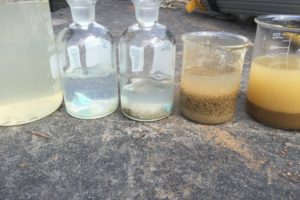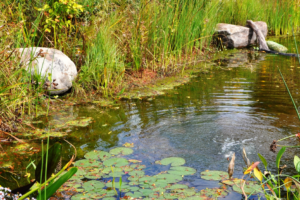When cattails overgrow a pond, they can lead to a range of issues. One problem is the ecological imbalance caused by their rapid growth and extensive root systems. Cattails outcompete native aquatic plants, reducing plant diversity and disrupting the ecosystem’s natural balance. This article will explain how to kill cattails in a pond.
Understanding Cattails
 Cattails are tall, perennial plants commonly found in wetland habitats such as ponds, marshes, and swamps. They have distinctive characteristics and growth patterns. Cattails have long, narrow, strap-like leaves that emerge from a central stem. The leaves are typically green and can reach lengths of up to three to ten feet. The stems are erect, sturdy, and hollow, providing structural support for the plant. One notable feature of cattails is their distinctive brown, cylindrical flower spikes. These spikes consist of numerous small, densely packed flowers that are either male or female. The male flowers are on the spike’s top portion, while the female flowers are below. The fluffy, cotton-like structures surrounding the female flowers contain the plant’s seeds and aid in wind dispersal.
Cattails are tall, perennial plants commonly found in wetland habitats such as ponds, marshes, and swamps. They have distinctive characteristics and growth patterns. Cattails have long, narrow, strap-like leaves that emerge from a central stem. The leaves are typically green and can reach lengths of up to three to ten feet. The stems are erect, sturdy, and hollow, providing structural support for the plant. One notable feature of cattails is their distinctive brown, cylindrical flower spikes. These spikes consist of numerous small, densely packed flowers that are either male or female. The male flowers are on the spike’s top portion, while the female flowers are below. The fluffy, cotton-like structures surrounding the female flowers contain the plant’s seeds and aid in wind dispersal.
Benefits and Drawbacks of Cattails
Having cattails in a pond has pros and cons.
Benefits:
- Wildlife Habitat
- Erosion Control
- Water Filtration
Drawbacks:
- Ecological Imbalance
- Reduced Water Flow
- Alteration of Habitat Structure
It is essential to strike a balance when managing cattails in a pond, ensuring their benefits are preserved while addressing any negative impacts they may cause.
What Kills Cattails?
Killing cattails can be achieved through several methods, which may be used alone or in combination. So, how do you kill cattails in a pond by mechanical, chemical, or biological means?
Mechanical Removal
Mechanical removal, specifically utilizing equipment like the Truxor, can be an effective method for removing cattails. The Truxor is an amphibious machine designed for vegetation management in aquatic environments. Learn more about cattail removal equipment here.
With specialized attachments, such as cutting heads or rakes, the Truxor can efficiently cut and remove cattails from ponds and wetland areas. Its versatility allows precision in targeting cattails while minimizing damage to surrounding vegetation. Mechanical removal with Truxor offers a practical and eco-friendly solution for controlling cattail overgrowth and restoring the balance of aquatic ecosystems.
Chemical Treatments
Chemical treatments are commonly used to remove cattails in aquatic environments. Selective herbicides designed for aquatic use can target and kill cattails while minimizing harm to non-target plants and wildlife.
The choice of herbicide and its application method depends on factors such as the extent of cattail growth and the specific pond conditions. Chemical treatments provide an efficient and targeted approach to cattail control, allowing for effective management and restoration of ponds and wetland habitats. One of the best herbicides to kill cattails is Imox herbicide. All herbicides should be handled with care (and should be applied by trained professionals with the right personal protective equipment).
Biological Control
Biological control offers a natural and environmentally friendly approach to removing cattails. This method involves the introduction of natural predators or biological agents that specifically target cattails.
Proper research, monitoring, and assessment of the ecosystem are crucial to determine the suitability and effectiveness of biological control for cattail removal. When implemented correctly, biological control can provide a sustainable and long-term solution for managing cattail overgrowth in ponds and wetland environments.
The Best Way to Kill Cattails
Several measures can be taken to prevent cattail regrowth. One approach is to ensure thorough removal of the entire plant, including the roots and rhizomes, during control efforts. This minimizes the chances of regrowth from any remaining plant parts.
Maintaining proper water levels and pond flow can also help prevent cattail regrowth, as they thrive in stagnant or slow-moving water. Implementing regular maintenance practices, such as mowing or cutting cattails before they reach maturity, can weaken their growth and prevent seed production.
Promoting a diverse aquatic plant community by introducing native species can also help prevent cattail dominance by increasing resource competition.
Monitoring the pond regularly and promptly addressing any new cattail growth can aid in preventing regrowth and maintaining control over time.
Regular maintenance plays a vital role in preventing cattail regrowth. Their growth can be suppressed by implementing consistent and proactive measures, such as mowing, cutting, or pulling out cattails.
Routinely removing cattails before they reach maturity disrupts their reproductive cycle, preventing seed production and dispersal. Maintaining a consistent schedule for maintenance activities reduces the chance of cattails establishing a strong foothold and outcompeting other desirable plant species.
By staying proactive and vigilant in removing cattails regularly, the pond ecosystem can be effectively managed, preventing the regrowth of cattails and promoting a healthy and balanced aquatic environment.
Want to Learn More about How to Kill Cattails in a Pond?
PondMedics is here to help. Our team of experts specializes in pond management and can provide effective solutions for cattail removal. We offer various services tailored to your needs, from mechanical removal to chemical treatments. Our expertise and experience can restore balance to your pond and create a healthier, more vibrant aquatic ecosystem. Don’t let cattails take over your pond any longer. Contact PondMedics today and let us help you reclaim your beautiful pond.





